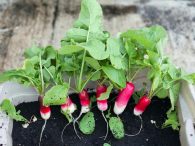Radishes or radishes are vegetables of the cruciferous family, the root is cultivated because it provides the horticulturist with an excellent fresh vegetable, very suitable for consumption in salads.
It is a plant quite resistant to pest attacks, with a short crop cycle (generally around 30 days).
It can therefore be excellent to grow in the family garden with gradual sowing to always be provided with vegetables to harvest and eat.
Ideal soil and climate for cultivation
Climate. The climate must not be too hot, the radish likes a good sun exposure but a temperate or cool climate.
Type of terrain. The radish plant requires loose, draining soil, preferably calcareous. To grow it in vegetable gardens with compact and heavy soil, and must be added a couple of months before sowing.
Fertilization and processing of the vegetable garden. The soil must be well worked, reaching to dig deep, the fertilizer must be used in moderation, taking into account that an excess of nitrogen causes the growth of the aerial part of the plant, to the detriment of the root which is what interests the horticulturist.
Sowing period. Radishes can be sown from the beginning of spring to the end of summer, depending on the variety, a crop cycle of 30-40 days is taken into account, so it is possible to program sowing to harvest gradually depending on consumption.
How to sow. The radishes are sown directly in the ground, planting the seed in the garden about one centimeter deep.
A sixth of implant. Radish is generally grown in rows 20 cm apart, with distances of 4/5 cm between the seedlings. It can also be sown by broadcasting and then subsequently thinning out the plants.
How they are grown in the organic garden and when to harvest them
Thin out. It is a fairly quick plant to germinate, after about ten days the radish seedlings are thinned out so that each root finds its correct space. The distance to leave is at least 3 cm, if the variety has large roots it thins out to 5-6 cm between the plants.
Irrigation. Radish requires a constant and balanced amount of water: too much irrigation causes important foliar growth but with poor root development, the lack of water makes the root woody and spicy in flavor.
Weeding and hoeing. The garden bed dedicated to radishes must be kept clean from weeds with weeding. The earth must then be hoed periodically to aerate and soften the soil.
Collection. The radish is harvested about a month after sowing, the winter ones require a longer time, even two months. If the root remains in the ground for a long time, it hardens and becomes spicy.
Intercropping. The radish goes well with all vegetables, being also an undemanding plant. It is only suggested not to make it happen other crucifers. It is said that the association with lettuce improves the taste of the radish making it less spicy.
What are the enemies and diseases of this vegetable
The radish suffers the attacks of the same parasites that affect the vegetables of its family, the insects to be careful of are therefore the same ones that affect the cabbage, these are Grillot mole, noctuids, and aphids.
Particularly annoying to radishes are the anchovies, or ground fleas that pierce the leaves and compromise the harvest. While the larvae of the anchovies erode the underground part, the adult beetles eat the aerial part. At the first signs, it is necessary to kill the anchovies with pyrethrum.
Given the short crop cycle, fungal diseases such as downy mildew or fusarium generally fail to do great damage to radishes.
Properties of radishes
Radishes are vegetables rich in nutrients: they contain vitamins B and C, potassium, phosphorus, calcium, and iron. It is said that they have a tranquilizing effect by promoting sleep and that they are good for asthma, they are also attributed to digestive, purifying, and diuretic properties.
Varieties of radish
- Saxa: round-shaped root and red rind, early radish variety.
- Ice candle: white pulp and rind, elongated shape, medium late, crop cycle of about 20-30 days.
- Giant butter radish: crunchy pulp, a medium-late cycle of 30 days, round red root.
- Giant Sicilian: red radish, variety suitable for hot climates, for summer cultivation.
- Flamboyant: large red radish.



